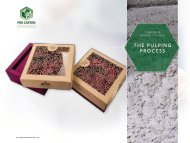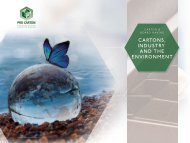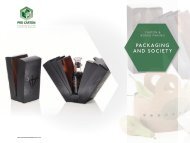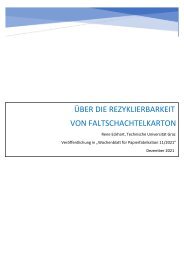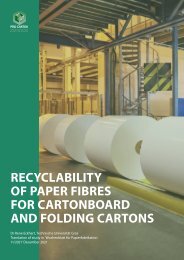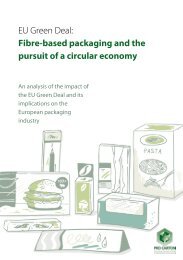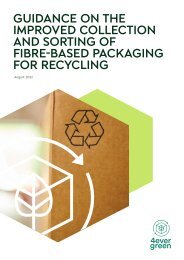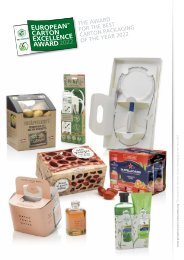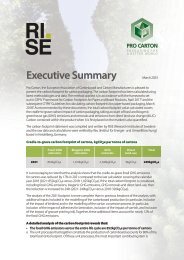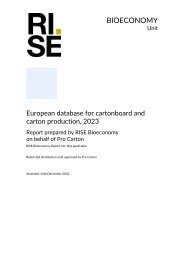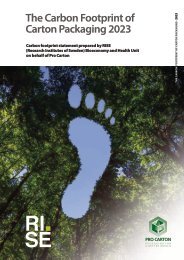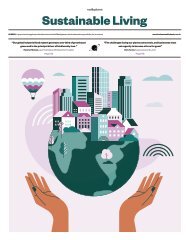RAMBOLL LCA Study (Executive Summary)
- No tags were found...
Create successful ePaper yourself
Turn your PDF publications into a flip-book with our unique Google optimized e-Paper software.
SINGLE-USE VS MULTIPLE-USE<br />
USING SCIENCE TO CHALLENGE THE MISCONCEPTIONS<br />
Paper<br />
Single<br />
use<br />
Single-use paper packaging in Quick Service<br />
Restaurants is better for the environment than reusable<br />
tableware, says new European study from Ramboll.<br />
<strong>Study</strong> challenges common perception that reusable<br />
tableware has lower environmental impacts.<br />
January 2021<br />
Life Circle Assesment <strong>Study</strong> carried out by <strong>RAMBOLL</strong> for<br />
EPPA - European Paper Packaging Alliance<br />
Document type<br />
<strong>Executive</strong> <strong>Summary</strong><br />
COMPARATIVE LIFE-CYCLE ASSESSMENT (<strong>LCA</strong>) SINGLE-USE AND MULTIPLE-USE DISHES SYSTEMS FOR IN-STORE CONSUMPTION IN QUICK SERVICE RESTAURANTS<br />
1
INTRODUCTION<br />
Ramboll 1 , has been appointed by the European Paper Packaging<br />
Alliance (EPPA 2 ) as technical consultant for conducting a comparative<br />
Life Cycle Assessment (<strong>LCA</strong>) study between a paper single-use dishes<br />
system and equivalent multiple-use dishes in Quick Service Restaurants<br />
(hereafter “QSRs”) in accordance with ISO standards 14040 and 14044<br />
as a basis for discussion with authority representatives on the current<br />
legal developments within the European Union plus the United Kingdom<br />
regarding circular economy and waste prevention.<br />
In particular, EPPA wishes to provide policy makers with technical, scientific<br />
data to support the application of the 2008 Waste Directive, so that<br />
“when applying the waste hierarchy, Member States shall take measures<br />
to encourage the options that deliver the best overall environmental<br />
outcome. This may require specific waste streams departing from<br />
the hierarchy where this is justified by life-cycle thinking on the<br />
overall impacts of the generation and management of such waste”<br />
(Directive 2008/98/EC, article 4§2)<br />
This assessment is embedded in an ongoing debate around the<br />
environmental performance of single-use and multiple-use products<br />
and it is focused on a systemic approach (comprehensive dishes options<br />
for in-store consumption in QSR) which is used to reflect both systems<br />
and compare equal functions of single-use and multiple-use product<br />
items in an average.<br />
The functional unit was the in-store consumption of foodstuff and<br />
beverages with single-use or multiple-use dishes (including cups,<br />
lids, plates, containers and cutlery) in an average QSR for 365 days<br />
in Europe in consideration of established facilities and hygiene<br />
standards as well as QSR-specific characteristics (e.g. peak times,<br />
throughput of served dishes).<br />
1<br />
Ramboll is an independent engineering Danish company ranked second in environmental<br />
consulting in Western Europe and current consultant to the European Commission on various<br />
issues.<br />
2<br />
2<br />
EPPA is an association representing suppliers and manufacturers of renewable<br />
and sustainable paper board and paper board packaging for Food and Foodservice<br />
Industry. They include, e.g., AR Packaging, CEE Schisler Packaging Solutions, Huhtamaki,<br />
Iggesund/Holmen, Mayr-Melnhof Karton, Metsä Board, Paper Machinery Corporation,<br />
Reno De Medici, Seda International Packaging Group, Smith Anderson, Stora Enso, WestRock.<br />
COMPARATIVE LIFE-CYCLE ASSESSMENT (<strong>LCA</strong>) SINGLE-USE AND MULTIPLE-USE DISHES SYSTEMS FOR IN-STORE CONSUMPTION IN QUICK SERVICE RESTAURANTS
1. Comparative assesment<br />
For the comparative assessment, two fundamentally<br />
distinct systems are taken into consideration:<br />
Paper<br />
Single<br />
use<br />
VS<br />
Multiple<br />
use<br />
Single-use<br />
Multiple-use<br />
The current system in QSRs<br />
based on single-use products<br />
made of paperboard<br />
if coated, polyethylene content < 10% w/w<br />
Alternative system based on<br />
multiple-use different options, made<br />
of plastic-PP and<br />
ceramic, glass, metal and plastic-PP;<br />
washed and dried either in-store or<br />
out-of store<br />
The distinctive features of this study compared to other assessments<br />
within this field of research are the following:<br />
1. Geographical<br />
Scope<br />
This geographical boundary is<br />
reflected in the assumptions around<br />
the systems (e.g. recycling rates)<br />
and background datasets (e.g.<br />
electricity from grid) as inventory<br />
data for the manufacturing stage of<br />
certain products will be site-specific<br />
or representing average production<br />
scenarios (e.g. global, EU).<br />
2. System<br />
approach<br />
The main goal of the <strong>LCA</strong> study is to<br />
compare for the first time through a<br />
system approach the environmental<br />
performance of single-use and<br />
multiple-use dishes options for instore<br />
consumption in QSR in Europe<br />
and not focused on the environmental<br />
performance of a single product;<br />
3. Robustness<br />
of the data<br />
The study incorporates from primary<br />
sources data and information with regards<br />
to the functional unit, inventory data as well<br />
assumptions around the systems. Primary data<br />
and information (reflected in the functional<br />
unit) ffrom QSRs for the system description<br />
are obtained from EPPA members which<br />
market shares cover more than 65% of QSRs<br />
in Europe. This is particularly relevant since<br />
previous <strong>LCA</strong> studies based on secondary<br />
data for paper upstream processes are not<br />
anymore representing state-of-the art for the<br />
investigated single-use system.<br />
COMPARATIVE LIFE-CYCLE ASSESSMENT (<strong>LCA</strong>) SINGLE-USE AND MULTIPLE-USE DISHES SYSTEMS FOR IN-STORE CONSUMPTION IN QUICK SERVICE RESTAURANTS<br />
3
The comparative <strong>LCA</strong> study has taken into account<br />
a comprehensive use of 24 different food<br />
and beverage containers which are used in<br />
Quick Service Restaurants*:<br />
wrap/clamshell or<br />
plate/cover or tray<br />
cold/hot cup<br />
salad bowl<br />
with lid<br />
ice-cream<br />
cup<br />
cutlery set<br />
fry bag/basket<br />
fry carton<br />
* other food containers/packaging (i.e. shovel for coffee, placemat, drinking straw)<br />
are not included in the <strong>LCA</strong> study.<br />
In total, the comparative <strong>LCA</strong> assessment incorporates the life cycles of:<br />
10 14<br />
different single-use<br />
product items<br />
made of paperboard<br />
if coated, polyethylene<br />
content is < 10% w/w<br />
different multiple-use<br />
product items represented in different<br />
scenarios and sensitivity analyses with 2 dishes set<br />
options: one set made of polypropylene and one<br />
set combining PP, ceramic, glass and steel for<br />
sensitivity analyses.<br />
4<br />
COMPARATIVE LIFE-CYCLE ASSESSMENT (<strong>LCA</strong>) SINGLE-USE AND MULTIPLE-USE DISHES SYSTEMS FOR IN-STORE CONSUMPTION IN QUICK SERVICE RESTAURANTS
2. Baseline scenarios<br />
For the baseline scenarios<br />
the following key assumptions<br />
have been made:<br />
• Paper manufacturing refers to the<br />
European geographical context of<br />
the paper mill or manufacturer from which<br />
primary data is used and is considered<br />
representative for EU-average supply chain<br />
• Products are made solely<br />
from virgin paper sourced from<br />
European renewable, certified, sustainable<br />
forest. The reforestation is contributing in<br />
very positive and sizeable manner to the<br />
absorption of CO 2<br />
.<br />
• Intermediate transport from paper<br />
producers to converters is modelled<br />
according to primary data provided<br />
by converters<br />
Paper<br />
Single<br />
use<br />
• Paper<br />
converting stage<br />
is modelled based<br />
on primary data<br />
obtained from<br />
converters located<br />
in representative<br />
European countries<br />
• End-of-life<br />
(paper products)<br />
o 30% paper recycling<br />
and 70% incineration with<br />
energy recovery for paper<br />
o Transport of waste from<br />
QSR to incineration facility<br />
is assumed to be 100 km.<br />
Paper fibers can typically<br />
be recycled up to 7 times<br />
• Types and amounts of packaging<br />
materials (cardboard and PE foils)<br />
for all single-use product items<br />
(except for wooden cutlery) are based on<br />
primary data from converters<br />
• Production paper wastes during<br />
converting (i.e. post-industrial wastes) are<br />
materially recycled as indicated in primary<br />
information obtained from converters.<br />
Paper and board packaging is the most recycled<br />
material in Europe with a rate of 85.6%<br />
COMPARATIVE LIFE-CYCLE ASSESSMENT (<strong>LCA</strong>) SINGLE-USE AND MULTIPLE-USE DISHES SYSTEMS FOR IN-STORE CONSUMPTION IN QUICK SERVICE RESTAURANTS<br />
5
• Polypropylene (PP) items assumed<br />
to be manufacturing in Europe<br />
• Average reuse PP<br />
rate of 100 reuses is<br />
considered. Reuse rates<br />
also include potential<br />
replacement reasons<br />
such as damages, stains,<br />
theft or loss. The latter<br />
reasons are considered to<br />
be relatively important in<br />
QSRs as higher volumes<br />
of product items are<br />
involved than in regular<br />
restaurants<br />
• End-of-life<br />
(PP products)<br />
o 30% material recycling<br />
and 70% incineration<br />
with energy recovery<br />
o Transport of waste<br />
from QSR to waste<br />
treatment facility is<br />
assumed to be 100 km<br />
Multiple<br />
use<br />
• Dishwashing process<br />
o An average scenario for in-house dishwashers is used to reflect different grades of devices’ efficiencies<br />
o Internal washing is assumed with a separate drying module because of hygienic requirements and increased efforts for drying<br />
of PP products based on literature information, 30% of total energy demand of washing and drying comes from drying; thus energy<br />
demands for washing reported in literature were increased by +30% if the device does not perform sufficient drying for PP products<br />
o State-of-the-art detergent and rinse agent compositions are assumed<br />
o Average rewashing rate for all items of 5% is considered, this assumption is made to avoid persistent residues that might remain<br />
after washing<br />
o Production of simplified dishwashers is considered (generic assumption of two additional devices to be installed inside a QSR to<br />
perform in-house washing; ten-year lifetime of the dishwasher)<br />
For the EoL (End-of-Life) assumption of the baseline scenarios it should be noted that generic<br />
plastic packaging shows EU average recycling figures (about 40% below the European target<br />
set 55 % on 25 %) 2 lower than paper packaging (about 85% 3 and the european target is 75%).<br />
For data symmetry reasons in the comparison and due to the lack of product-specific recycling<br />
rates, 30% material recycling and 70% incineration with energy recovery are assumed for both<br />
baseline scenarios, provided that appropriate sorting of post-consumer waste fractions is<br />
facilitated at the EoL stage.<br />
Sensitivity analyses are performed for 0% recycling and 100% incineration with energy recovery<br />
and for 70% material recycling and 30% incineration with energy recovery for both systems.<br />
2<br />
https://ec.europa.eu/eurostat/databrowser/view/ten00063/default/table?lang=en<br />
3<br />
https://ec.europa.eu/eurostat/databrowser/view/ten00063/default/table?lang=en<br />
6<br />
COMPARATIVE LIFE-CYCLE ASSESSMENT (<strong>LCA</strong>) SINGLE-USE AND MULTIPLE-USE DISHES SYSTEMS FOR IN-STORE CONSUMPTION IN QUICK SERVICE RESTAURANTS
PAPER<br />
SINGLE-USE SYSTEM<br />
MULTIPLE-USE<br />
SYSTEM<br />
Climate<br />
change<br />
VERY SIGNIFICANT<br />
BENEFITS FOR<br />
SINGLE-USE<br />
+177%<br />
HIGHER IMPACTS<br />
OF MULTIPLE-USE<br />
BASELINE SCENARIO<br />
Freshwater<br />
Consumption<br />
VERY SIGNIFICANT<br />
BENEFITS FOR<br />
SINGLE-USE<br />
+267%<br />
HIGHER IMPACTS<br />
OF MULTIPLE-USE<br />
BASELINE SCENARIO<br />
Fossil<br />
Depletion<br />
VERY SIGNIFICANT<br />
BENEFITS FOR<br />
SINGLE-USE<br />
+238%<br />
HIGHER IMPACTS<br />
OF MULTIPLE-USE<br />
BASELINE SCENARIO<br />
Fine Particulate<br />
Matter Formation<br />
VERY SIGNIFICANT<br />
BENEFITS FOR<br />
SINGLE-USE<br />
+132%<br />
HIGHER IMPACTS<br />
OF MULTIPLE-USE<br />
BASELINE SCENARIO<br />
Terrestrial<br />
Acidification<br />
VERY SIGNIFICANT<br />
BENEFITS FOR<br />
SINGLE-USE<br />
+72%<br />
HIGHER IMPACTS<br />
OF MULTIPLE-USE<br />
BASELINE SCENARIO<br />
Stratospheric<br />
Ozone Depletion<br />
NOTICEABLE<br />
BENEFITS FOR<br />
MULTIPLE-USE SYSTEM<br />
-11%<br />
LOWER IMPACTS<br />
OF MULTIPLE-USE<br />
BASELINE SCENARIO<br />
Metal<br />
Depletion<br />
NOTICEABLE<br />
BENEFITS FOR<br />
MULTIPLE-USE SYSTEM<br />
-12%<br />
LOWER IMPACTS<br />
OF MULTIPLE-USE<br />
BASELINE SCENARIO<br />
Ionizing<br />
Radiation<br />
SIGNIFICANT<br />
BENEFITS FOR<br />
MULTIPLE-USE SYSTEM<br />
-37%<br />
LOWER IMPACTS<br />
OF MULTIPLE-USE<br />
BASELINE SCENARIO<br />
Freshwater<br />
Eutrophication<br />
VERY SIGNIFICANT<br />
BENEFITS FOR<br />
MULTIPLE-USE SYSTEM<br />
-81%<br />
LOWER IMPACTS<br />
OF MULTIPLE-USE<br />
BASELINE SCENARIO<br />
Terminology used for interpretation based on relative difference in % based on the respective indicated single-use system as reference value<br />
(e.g. baseline scenario): 50%: very significant difference<br />
7
Impact Assessment categories<br />
Explanations<br />
Climate<br />
change<br />
Climate Change is the defining issue of our time and we are at a<br />
defining moment. From shifting weather patterns that threaten food<br />
production, to rising sea levels that increase the risk of catastrophic<br />
flooding, the impacts of climate change are global in scope and<br />
unprecedented in scale. Without drastic action today, adapting to<br />
these impacts in the future will be more difficult and costly.<br />
The most abundant GHG, accounting for about two-thirds of GHGs,<br />
carbon dioxide (CO2), is largely the product of burning fossil fuels.<br />
Freshwater<br />
Consumption<br />
Water scarcity is a rapidly growing concern around the globe, but<br />
little is known about how it has developed over time. Water scarcity<br />
is analysed using the fundamental concepts of shortage (impacts<br />
due to low availability per capita) and stress (impacts due to high<br />
consumption relative to availability) which indicate difficulties<br />
in satisfying the needs of a population and overuse of resources<br />
respectively. While water consumption increased fourfold within 1900s<br />
to 2000s, the population under water scarcity increased from 0.24<br />
billion (14% of global population) in the 1900s to 3.8 billion (58%) in<br />
the 2000s. Nearly all sub-national trajectories show an increasing<br />
trend in water scarcity.<br />
Fossil<br />
Depletion<br />
This impact category indicator is related to the use of fossil fuels.<br />
Fossil fuels provide a valuable source of energy and feedstock for<br />
materials such as plastics. Although there are alternatives, these are<br />
only able to replace a small proportion of our current use. Fossil fuels<br />
are a finite resource and their continued consumption will make them<br />
unavailable for use by future generation.<br />
Fine Particulate<br />
Matter Formation<br />
Fine particulate matter (PM) in the ambient air is implicated in a<br />
variety of human health issues throughout the globe. Vehicular traffic<br />
has a significant influence on PM2.5 levels in urban areas; followed by<br />
combustion activities (biomass, industrial, and waste burning) and<br />
road dust. In urban atmosphere, fine particles are mostly associated<br />
with different health effects with old aged people, pregnant women,<br />
and more so children being the most susceptible ones. Fine PM<br />
chemical constituents severely effect health due to their carcinogenic<br />
or mutagenic nature.<br />
8<br />
COMPARATIVE LIFE-CYCLE ASSESSMENT (<strong>LCA</strong>) SINGLE-USE AND MULTIPLE-USE DISHES SYSTEMS FOR IN-STORE CONSUMPTION IN QUICK SERVICE RESTAURANTS
Impact Assessment categories<br />
Explanations<br />
Terrestrial<br />
Acidification<br />
Atmospheric emissions of acidifying substances such as sulphur<br />
dioxide (SO2) and nitrogen oxides (NOx), mainly from the burning<br />
of fossil fuels, can persist in the air for up to a few days and thus can<br />
be transported over thousands of kilometres, when they undergo<br />
chemical conversion into acids (sulphuric and nitric). The primary<br />
pollutants sulphur dioxide, nitrogen dioxide and ammonia (NH3),<br />
together with their reaction products, lead after their deposition to<br />
changes in the chemical composition of the soil and surface water.<br />
This process interferes with ecosystems, leading to what is termed<br />
‘acidification’. Acidifying substances also play a role in the greenhouse<br />
effect Furthermore, nitrogen oxides contribute to the ozone problems<br />
(build-up of tropospheric ozone, depletion of stratospheric ozone),<br />
and, together with ammonia, contribute to the nitrogen fertilisation<br />
of natural terrestrial ecosystems; with phosphate they contribute to<br />
eutrophication in water.<br />
Stratospheric<br />
Ozone Depletion<br />
The so-called ozone layer is located between 10 and 50 km above<br />
the Earth’s surface and contains approximately 90 per cent of all<br />
atmospheric ozone. Under undisturbed conditions stratospheric<br />
ozone is formed as the result of a photochemical equilibrium involving<br />
oxygen molecules, oxygen atoms and solar radiation. The ozone layer<br />
protects life on the Earth’s surface since ozone is the only efficient<br />
absorbent of the ultraviolet-B radiation (wavelengths 280 to 310 nm)<br />
from the sun. UV-B radiation is harmful to organisms in many ways.<br />
Metal<br />
Depletion<br />
Technological advancements dictate the productivity growth in all<br />
industries, including extractive ones. In the peculiar case of metallic<br />
mineral industries, this growth is also impacted by the natural variation<br />
in the metal content and chemical composition of the ore input, in the<br />
course of cumulative extraction and depletion of resources.<br />
Ionizing<br />
Radiation<br />
This category includes the generation of electricity from both coal<br />
and nuclear power plants, the transportation of nuclear materials,<br />
and the storage of nuclear wastes. It also includes the exposures<br />
from fallout from the international nuclear weapons testing programs.<br />
These sources make up less than one percent of the annual radiation<br />
exposure. Others sources include naturally occurring radioactive<br />
material, cosmic radiation and nuclear medicine<br />
Freshwater<br />
Eutrophication<br />
A process of pollution that occurs when a lake or stream becomes<br />
over-rich in plant nutrient; as a consequence it becomes overgrown<br />
in algae and other aquatic plants. The plants die and decompose. In<br />
decomposing the plants rob the water of oxygen and the lake, river or<br />
stream becomes lifeless. Nitrate fertilizers which drain from the fields,<br />
nutrients from animal wastes and human sewage are the primary<br />
causes of eutrophication.<br />
COMPARATIVE LIFE-CYCLE ASSESSMENT (<strong>LCA</strong>) SINGLE-USE AND MULTIPLE-USE DISHES SYSTEMS FOR IN-STORE CONSUMPTION IN QUICK SERVICE RESTAURANTS<br />
9
3. Sensitivity analysis<br />
For the sensitivity analysis and respective scenarios only one parameter<br />
or assumption has been changed per system in order to maintain transparency<br />
and ensure traceability of results.<br />
The following sensitivity analyses<br />
have been performed:<br />
1. Single-use system: Different recycling rates of<br />
post-consumer paperboard (0%; 70%);<br />
2. Multiple-use system: Different recycling rates of<br />
post-consumer PP items (0%; 70%);<br />
3. Multiple-use system: Varied demand for multiple-use<br />
items (30% higher; 30% lower);<br />
4. Multiple-use system: Optimised washing scenario;<br />
5. Multiple-use system: External washing with band<br />
transport dishwasher;<br />
6. Multiple-use system: Alternative multiple-use items<br />
(dishes made from ceramic (500 or 250 reuses),<br />
glass (500 or 250 reuses), stainless steel (1000 reuses)<br />
and PP (100 reuses);<br />
7. Both systems: Different EoL allocation approach<br />
for avoided energy and material production (50:50)<br />
Environmental benefits for the single-use system<br />
are consistent throughout all considered scenarios<br />
in terms of Climate Change, Freshwater Consumption,<br />
Fossil Depletion, Fine Particulate Matter<br />
and Terrestrial Acidification<br />
10<br />
COMPARATIVE LIFE-CYCLE ASSESSMENT (<strong>LCA</strong>) SINGLE-USE AND MULTIPLE-USE DISHES SYSTEMS FOR IN-STORE CONSUMPTION IN QUICK SERVICE RESTAURANTS
4. Key findings and Conclusion<br />
Ramboll <strong>LCA</strong> is unique in its approach based on a “system to system”<br />
comparison, different from the usual “product to product” approach that does<br />
not consider the cumulative impacts of the different products<br />
on the environment<br />
Ramboll <strong>LCA</strong> is an ISO 14040 and 14044 compliant study<br />
based on primary updated data from:<br />
• QSR in the functioning and quantification<br />
of the system studied<br />
• Paper manufacturer and converters for<br />
Single-Use food packaging products<br />
• Dishwashers and driers process<br />
Realistic and symmetric hypothesis are taken for both systems<br />
Sensitivity analysis demonstrates that Paper Single-Use<br />
environmental advantages are consistent throughout all<br />
considered scenarios.<br />
While the single-use system is characterised by rather<br />
centralised large, industrialised operators with continuous<br />
environmental improvement systems in place, the environmental<br />
implications of multiple-use system may be characterised by<br />
decentralised and less organised actors.<br />
As QSR are rather standardized stores, the main differences between<br />
EU countries mostly rely on:<br />
• The electricity mix, and its carbon impact level<br />
• The end of Life and recycling required rates<br />
This <strong>LCA</strong> meets ISO standards and has been independently<br />
assessed by Germany’s TÜV (Technischer Überwachungsverein).<br />
All significant parameters are available and representative and<br />
have been systematically derived and duly assessed. All type<br />
approvals have been checked. The assessments and the underlying<br />
data collection and calculation procedures are transparent and<br />
traceable<br />
COMPARATIVE LIFE-CYCLE ASSESSMENT (<strong>LCA</strong>) SINGLE-USE AND MULTIPLE-USE DISHES SYSTEMS FOR IN-STORE CONSUMPTION IN QUICK SERVICE RESTAURANTS<br />
11
4. Key findings and Conclusion<br />
Additional Single-Use advantages not included in the <strong>LCA</strong><br />
PAPER SINGLE-USE<br />
• Paper Single-Use dishes are sourced and manufactured in Europe,<br />
opposite to plastic, ceramic or glass dishes that are sourced<br />
and/or manufacture out of Europe, mostly in Asia and China.<br />
In the case of plastic, the most realistic and base case scenario, a<br />
massive substitution could lead to hundreds million plastic tons per<br />
year mostly coming from China whereas paper/board dishes are<br />
coming from EU sustainable forests<br />
• Single-Use dishes and food packaging are a perfect fit for a circular<br />
economy because of their complete and effective recyclability:<br />
they provide valuable fiber products that can be re-used up to seven<br />
times for paper or board production, and the thin plastic layer they<br />
contain is also recyclable. Enhancing the existing recycling system is<br />
one of EPPA’s priorities.<br />
• Single-Use paper dishes and packaging are hygienic products:<br />
they best protect the food and prevent cross-contamination, as<br />
demonstrated in many studies and is the “only feasible option for<br />
maintaining adequate food hygiene, public health and consumer<br />
safety” (Professor McDowell 2020 report)<br />
• If the study scope was take-away, additional environmental<br />
burden would have to be taken into account :<br />
- An additional ride to take back the multiple use dishes<br />
- A less performant dishwasher energy consumption<br />
related to a larger number of small restaurants<br />
- A higher non-return rate for multiple use packaging<br />
related to deposit scheme<br />
• Single-use food packaging is a critical enabler of the whole<br />
value chain, as demonstrated in Covid times<br />
12<br />
COMPARATIVE LIFE-CYCLE ASSESSMENT (<strong>LCA</strong>) SINGLE-USE AND MULTIPLE-USE DISHES SYSTEMS FOR IN-STORE CONSUMPTION IN QUICK SERVICE RESTAURANTS
COMPARATIVE LIFE-CYCLE ASSESSMENT (<strong>LCA</strong>) SINGLE-USE AND MULTIPLE-USE DISHES SYSTEMS FOR IN-STORE CONSUMPTION IN QUICK SERVICE RESTAURANTS<br />
13



